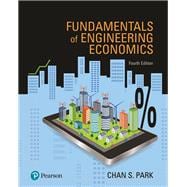This loose-leaf, three-hole punched version of the textbook gives students the flexibility to take only what they need to class and add their own notes—all at an affordable price.
Relate engineering economics to students’ everyday lives for theoretical and conceptual understanding
Chan Park, author of the best-selling Contemporary Engineering Economics, tells the story of engineering economy with the more concise Fundamentals of Engineering Economics by relating concepts from class to students’ everyday lives. This book provides sound and comprehensive coverage of course concepts while addressing both the theoretical and the practical concerns of engineering economics. Written to appeal to a wide range of engineering disciplines, the text helps students build skills in making informed financial decisions and incorporates all critical decision-making tools, including the most contemporary, computer-oriented ones. For the first time, MyLab™ Engineering is available for the 4th Edition, providing online homework with immediate feedback, the complete eText, and more.
Also available with MyLab Engineering
MyLab™ is the teaching and learning platform that empowers instructors to reach every student. By combining trusted author content with digital tools and a flexible platform, MyLab personalizes the learning experience and improves results for each student.Algorithmically generated questions and problems can be assigned by instructors as automatically graded homework or provide students with self-testing and practice opportunities.
Note: You are purchasing a standalone product; MyLab Engineering does not come packaged with this content. Students, if interested in purchasing this title with MyLab Engineering, ask your instructor for the correct package ISBN and Course ID. Instructors, contact your Pearson representative for more information.
If you would like to purchase boththe physical text and MyLab Engineering, search for:
0134872754 / 9780134872759 Fundamentals of Engineering Economics Plus MyEngineeringLab with Pearson eText -- Access Card Package
Package consists of:
- 0134831683 / 9780134831688 MyEngineeringLab with Pearson eText -- Access Card -- for Fundamentals of Engineering Economics
- 0134870077 / 9780134870076 Fundamentals of Engineering Economics











